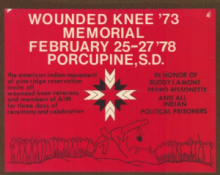Article
On February 28, 1973, Native American activists occupied the small village of Wounded Knee within the Pine Ridge Reservation in South Dakota as a part of the American Indian Movement, after the 19 month occupation of Alcatraz. Wounded Knee was also the site of a massacre of Lakota Sioux by the US Army in 1890, which is considered the last event in long-lasting Plains Indian Wars.
The seizure of the town lasted for 71 days with various eruptions of violence, gunfire, and attempted negotiations. At any given moment, about 300 people were participating in the occupation from over 180 unique bands, tribes, and nations. Even though the village was surrounded by police, US marshals, and BIA officials, a couple hundred more protesters slipped in and out of the occupation.
Originally, local issues on the Pine Ridge Reservation involving tribal police and inheritance conflicts led to the occupation, and many community members supported and took part in what became Aim's more public protest. After threats from the federal government that if they didn't leave, he would force them out, Russel Means declared that the people of Wounded Knee were part of the independent Oglala Sioux Nation as per the Fort Laramie Treaty of 1868 which also symbolically spoke for all the broken treaties of the United States government since the start of colonization.
Ultimately, several factors including the federal government's lack of cooperation, and a lack of food, medical supplies, ammunition, and electricity led to the end of the occupation on May 13. 1973.
"Wounded Knee 1973 Memorial," photograph by Barbara M. Camaron; American Indian Movement. UNM CSWR Allen Cooper Papers (MSS 925-013). Center for Southwest Research, University of New Mexico.
Manuscripts
References
Johnson, Troy R.
2014 "Wounded Knee Occupation (1973)." The American Mosaic: The American Indian Experience. http://americanindian2.abc-clio.com/Feature/Story/1841144?sid=1385400&u…, accessed June 18, 2014.
The American Mosaic
2014 "carter Camp and the Wounded Knee Occupation: Background." The American Mosaic: The American Indian Experience.http://americanindian2.abc-clio.com/Feature/Story/1841144?cid=1841145&t…, accessed June 18, 2014.

